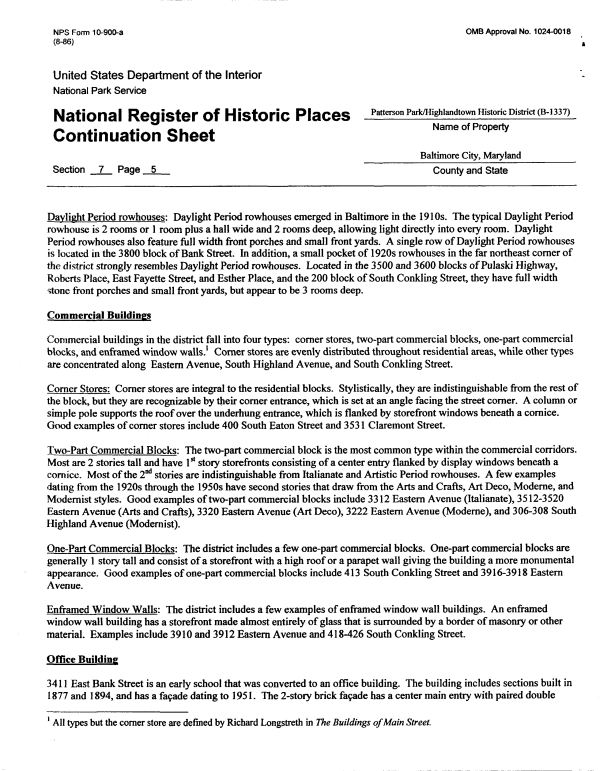 |
||||
|
DEPARTMENT OF HOUSING AND COMMUNITY DEVELOPMENT, MARYLAND HISTORICAL TRUST (Historic Sites Survey) var.d. MSA SE16-3 Image No: se16-3-0090 Enlarge and print image (81K) |
 |
||||
|
DEPARTMENT OF HOUSING AND COMMUNITY DEVELOPMENT, MARYLAND HISTORICAL TRUST (Historic Sites Survey) var.d. MSA SE16-3 Image No: se16-3-0090 Enlarge and print image (81K) |
| NFS Form 10-900-a OMB Approval No. 1024-0018 (8-86) United States Department of the Interior National Park Service National Register of Historic Places PattCTSon Pa^ighiandtown Historic District &. ^ . . *%• - Name of Property Continuation Sheet Baltimore City, Maryland Section 7 Page 5 County and State Daylight Period rowhouses: Daylight Period rowhouses emerged in Baltimore in the 1910s. The typical Daylight Period rowhouse is 2 rooms or 1 room plus a hall wide and 2 rooms deep, allowing light directly into every room. Daylight Period rowhouses also feature full width front porches and small front yards. A single row of Daylight Period rowhouses is located in the 3800 block of Bank Street. In addition, a small pocket of 1920s rowhouses in the far northeast corner of the district strongly resembles Daylight Period rowhouses. Located in the 3500 and 3600 blocks of Pulaski Highway, Roberts Place, East Fayette Street, and Esther Place, and the 200 block of South Conkling Street, they have full width stone front porches and small front yards, but appear to be 3 rooms deep. Commercial Buildings Commercial buildings in the district fall into four types: corner stores, two-part commercial blocks, one-part commercial blocks, and enframed window walls.1 Corner stores are evenly distributed throughout residential areas, while other types are concentrated along Eastern Avenue, South Highland Avenue, and South Conkling Street. Corner Stores: Corner stores are integral to the residential blocks. Stylistically, they are indistinguishable from the rest of the block, but they are recognizable by their corner entrance, which is set at an angle facing the street comer. A column or simple pole supports the roof over the underhung entrance, which is flanked by storefront windows beneath a cornice. Good examples of corner stores include 400 South Eaton Street and 3531 Claremont Street. Two-Part Commercial Blocks: The two-part commercial block is the most common type within the commercial corridors. Most are 2 stories tall and have 1st story storefronts consisting of a center entry flanked by display windows beneath a cornice. Most of the 2nd stories are indistinguishable from Italianate and Artistic Period rowhouses. A few examples dating from the 1920s through the 1950s have second stories that draw from the Arts and Crafts, Art Deco, Moderne, and Modernist styles. Good examples of two-part commercial blocks include 3312 Eastern Avenue (Italianate), 3512-3520 Eastern Avenue (Arts and Crafts), 3320 Eastern Avenue (Art Deco), 3222 Eastern Avenue (Moderne), and 306-308 South Highland Avenue (Modernist). One-Part Commercial Blocks: The district includes a few one-part commercial blocks. One-part commercial blocks are generally 1 story tall and consist of a storefront with a high roof or a parapet wall giving the building a more monumental appearance. Good examples of one-part commercial blocks include 413 South Conkling Street and 3916-3918 Eastern Avenue. Enframed Window Walls: The district includes a few examples of enframed window wall buildings. An enframed window wall building has a storefront made almost entirely of glass that is surrounded by a border of masonry or other material. Examples include 3910 and 3912 Eastern Avenue and 418-426 South Conkling Street. Office Building 3411 East Bank Street is an early school that was converted to an office building. The building includes sections built in 1877 and 1894, and has a fa9ade dating to 1951. The 2-story brick facade has a center main entry with paired double All types but the corner store are defined by Richard Longstreth in The Buildings of Main Street. |